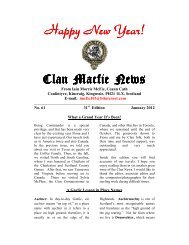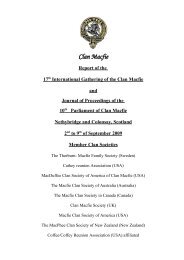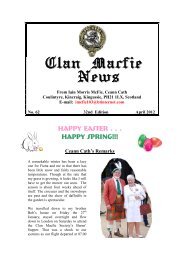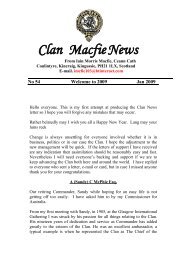Mythology, traditions and history - The Clan Macfie Society
Mythology, traditions and history - The Clan Macfie Society
Mythology, traditions and history - The Clan Macfie Society
Create successful ePaper yourself
Turn your PDF publications into a flip-book with our unique Google optimized e-Paper software.
- 38 -<br />
Eugene C. Barker claims that from 1770 to 1820 two million persons had moved west,<br />
composed of people from the Atlantic States <strong>and</strong> from Europe. 1 <strong>The</strong> Scotch-Irish moved from<br />
Kentucky, Virginia <strong>and</strong> West Pennsylvania; they moved chiefly on the northern route. Other<br />
nationals moved west to Louisiana <strong>and</strong> Texas <strong>and</strong> thence to Wyoming, New Mexico, Colorado<br />
<strong>and</strong> San Diego.<br />
<strong>The</strong> movement was very substantial from 1850 onwards. I have examined the fourteen<br />
volumes listed below looking for references to the clan. In the period 1850-1859 Scotl<strong>and</strong> sent<br />
36,561; Irel<strong>and</strong> provided 1,029,486, most of whom were from areas other than Ulster; Canada,<br />
according to Carrothers, sent sixty percent of her immigrants to United States. It is certain that<br />
a part of the enormous growth of the middle <strong>and</strong> western territories <strong>and</strong> states were in receipt of<br />
clan members; even, as in Canada, they mined, they were engaged in the fur trade, they farmed,<br />
they fished, they ran river boats on the long rivers. <strong>The</strong>y may have been local politicians but<br />
there are no reports of our clan being engaged in community effort.<br />
<strong>The</strong> routes they followed may be indicated. When people started to move to Oregon a local<br />
leader brought them from Baltimore, Maryl<strong>and</strong>, Ohio, Indiana, Illinois, to St. Louis <strong>and</strong><br />
Independence. From there they proceeded to Williamette Valley. Another route was the Santa<br />
Fe Trail, starting from Leavenworth to Dodge City, passing along the Arkansas River, from<br />
Hutchinson <strong>and</strong> then divided on the way to Las Vegas, either by Wilson Bar or by crossing the<br />
Arkansas River near Bent's Fort to La Junta. A trip in 1834 failed but in 1842 <strong>and</strong> 1843 men<br />
<strong>and</strong> women crossed the Rockies from Independence, Kansas, through Fort Hall, through<br />
Waiilatpu to Whitman <strong>and</strong> by boats from Walla Walla to the Williamette Valley. A southern<br />
route from Richmond to Chatanooga in Tennessee,then to Memphis, to the Butterfield Southern<br />
Overl<strong>and</strong> Mail route took persons to El Paso, Texas. A road was developed which went to<br />
Tucson, to Los Angeles or San Diego.<br />
<strong>The</strong> Indians fought for their l<strong>and</strong>s, <strong>and</strong> many treaties were needed before the white man<br />
could be assured of the safety of his family. In the upper reaches of the great rivers, there were<br />
"Indian Territories", <strong>and</strong> around the Great Lakes, in 1790-1800; in 1850 l<strong>and</strong> west of<br />
Minnesota, Iowa, Missouri <strong>and</strong> Arkansas was still "Indian Territory". In reality "settlers" in the<br />
west were not "colonists"; they operated from a chain of forts until 1850. <strong>The</strong> Americans<br />
"colonized" from 1850 onwards; the Canadians did the same twenty five years later.<br />
<strong>The</strong> trips to the Pacific might be accomplished in one generation, or even two or three. I<br />
had assumed that in the <strong>history</strong> of the areas through which the trail led one might find that<br />
some members of our clan would have made a contribution in the pioneer areas.<br />
1 Barker, E.C.; Mexico <strong>and</strong> Texas, 1821-35. New York. 1965






